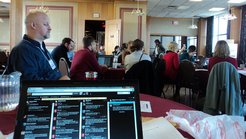 Election Day is over here in the United States and we appear to be on the brink of a significant social change. Fueled by outrage over the financial meltdown, economic stimulus attempts, government bailouts, and the election of Barack Obama, The Tea Party Movement is upending incumbents in the name of fiscal conservatism.
Election Day is over here in the United States and we appear to be on the brink of a significant social change. Fueled by outrage over the financial meltdown, economic stimulus attempts, government bailouts, and the election of Barack Obama, The Tea Party Movement is upending incumbents in the name of fiscal conservatism.
Many are pointing to the role of social media channels in spreading this movement. Did social media create the Tea Party Movement, and if so, does this prove that the social web can enable dramatic social change?
Just two years after a sweeping Democratic victory, the tea-party movement re-drew the landscape again. Nurtured by online networking, it helped disparate activists across the nation link up and already push aside high-profile incumbent leaders in multiple states this year.
A thorough history of the Tea Party Movement in The Wall Street Journal is peppered with references to the use of social media in building a national movement. Let’s start with a brief summary of how social media played a role in these sweeping changes:
Blogs
The genesis of the Tea Party Movement may have been a blog by Stacy Mott, a stay-at-home mother fed up with the government’s economic policies. Enraged by the government bail-outs, she started a blog for conservative women called “Smart Girl Politics” and launched a social networking site at the same time. This and other conservative blogs were catalysts for live rallies. The content caught the attention of influential blogger and political commentator Michelle Malkin who started to write about the rallies. After a dramatic online television rant calling for a modern-day Tea Party movement by CNBC Commentator Rick Santelli, the Smart Girl blog went viral. Hundreds of other blogs popped up, creating a grassroots cry for change.
Social networking
Facebook pages started springing up locally and then nationally, uniting disparate activities. The movement initially had no budget, so Facebook served as the central directory for the party’s activities. Within a year there 2,000 Tea Party-related Facebook pages. Eventually one of the founders created a website and social networking site called The Tea Party Patriots.
Twitter
Many believe the first seeds of the movement were planted on a list of top conservatives on Twitter, dubbed #tcot” for short. This list spawned other lists and within weeks #tcot grew from 25 names to 1,500. Twitter was used to unite disparate voices and organize conference calls, town hall meetings and rallies.
Wikis
As the movement grew, organizers established wikis to provide protest advice and organizing techniques.
Fueled by these social platforms, general disenchantment coalesced into a cause, and in just a few months the movement enjoyed a stunning victory when Republican Scott Brown in Massachusetts won Senator Ted Kennedy’s long-time Democratic Senate seat.
The social media revolution?
Undoubtedly social networking unified an idea among disparate interest groups with no organization and no budget. Does this amazing success discredit the much-discussed Malcom Gladwell article claiming that the weak links and lack of hierarchy could not promote such dramatic social change?
Yes and no. If you look carefully at the brief history of the Tea Party Movement, it may actually SUPPORT Gladwell’s contention.
The WSJ article shows the initial loose organizations created on social networks were eventually dismantled by in-fighting, controversy and hurt feelings. Once the euphoria of the initial change began to wear off, the social networks could not sustain the change and even the early pioneers united by blogs and Facebook became bitter and divided. Relationships among the loosely-based coalition deteriorated so quickly members began suing each other.
The real catalyst came from coverage by the traditional media. News programs on the Fox Network and articles in the New York Times and Wall Street Journal fueled interest in rallies. Live conference calls to organize the initiative seemed to be the linchpin between chaos and unity. Town Hall meetings and live rallies kept the momentum alive. Embarrassing content, like a racist photo-shopped images of the president, quickly went viral on the social web and actually created more divisiveness among the members.
The other important point that Gladwell was addressing was that revolutionary change requires risk to personal safety. Voting for the Tea Party Movement in the privacy of a voting booth carries the same risk as clicking a “like” button on Facebook so this is not exactly a test case for his theory.
In any event, there is no doubt that the Tea Party Movement could not have coalesced with this speed and forcefulness without social media. What are your thoughts on this Social Media Political Revolution?
Mark Schaefer
 Last Friday I had the distinct opportunity to attend, present and mingle with some of the “who’s who” of social media at UnGeeked Toronto, a three day social media retreat. The speaker list was extensive and reflective of the professionally social atmosphere. Guest speakers included:
Last Friday I had the distinct opportunity to attend, present and mingle with some of the “who’s who” of social media at UnGeeked Toronto, a three day social media retreat. The speaker list was extensive and reflective of the professionally social atmosphere. Guest speakers included: Mark Bowden @truthplane
Mark Bowden @truthplane Jeffrey Willinger @jwillie
Jeffrey Willinger @jwillie Karima-Catherine @karimacatherine
Karima-Catherine @karimacatherine Election Day is over here in the United States and we appear to be on the brink of a significant social change. Fueled by outrage over the financial meltdown, economic stimulus attempts, government bailouts, and the election of Barack Obama, The Tea Party Movement is upending incumbents in the name of fiscal conservatism.
Election Day is over here in the United States and we appear to be on the brink of a significant social change. Fueled by outrage over the financial meltdown, economic stimulus attempts, government bailouts, and the election of Barack Obama, The Tea Party Movement is upending incumbents in the name of fiscal conservatism. Ask a dozen professionals from a variety of endeavors to define marketing and you will likely receive variations on two or three different themes. Retailers, B-to-B enterprises, service providers, Fortune 500 companies, entrepreneurial start-ups – and everything in between — often view, plan and budget for marketing from unique perspectives.
Ask a dozen professionals from a variety of endeavors to define marketing and you will likely receive variations on two or three different themes. Retailers, B-to-B enterprises, service providers, Fortune 500 companies, entrepreneurial start-ups – and everything in between — often view, plan and budget for marketing from unique perspectives.